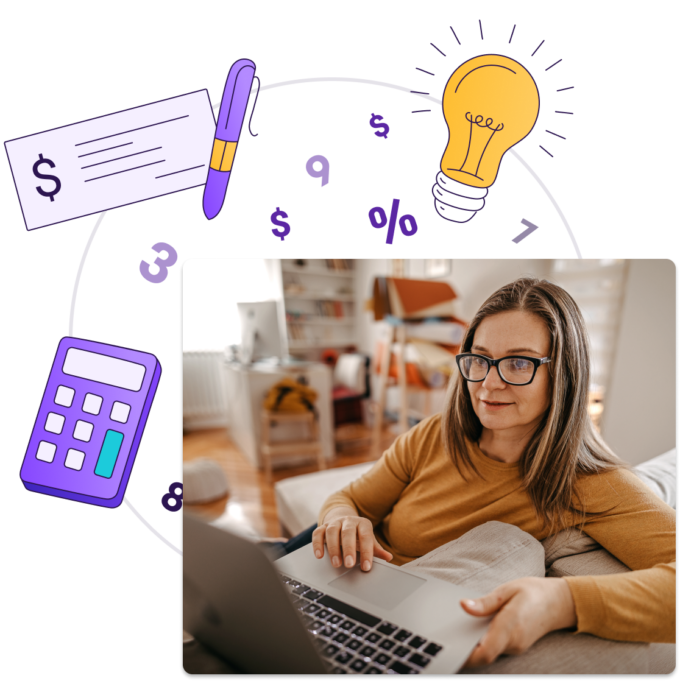How do I file for bankruptcy?
Learn how to file for bankruptcy and start your new financial future.
Filing for bankruptcy in Canada is a 5-step legal process that provides relief to individuals overwhelmed by debt. Our Licensed Insolvency Trustees (LITs) and debt solutions professionals will help you understand if bankruptcy is the right solution for you.

Before you begin
During the bankruptcy process, you’ll work closely with our team of debt solutions professionals, who will collect your necessary information and documents and guide you through the process.
After discussing other debt management options with your debt solutions professional, bankruptcy should be considered a last resort. Our debt repayment calculator can also help you better understand the solutions available.
Filing for bankruptcy
Here are the general steps you need to take to file for bankruptcy.
Book your free, confidential consultation with a debt solutions professional
During your consultation, one of our debt solutions professionals will work with you to assess your financial situation and suggest the best option for settling your debt. If bankruptcy is your ideal solution, they’ll review your assets, liabilities, income, and expenses and estimate your payment amount. The first appointment is always free, confidential, and judgment-free.
Have all documents for your bankruptcy prepared by us
After the consultation, if you decide that bankruptcy is your best path forward, your LIT will work with you and our team of debt solutions professionals to prepare the necessary paperwork. You may be required to provide additional documentation, especially if your bankruptcy includes assets.
Review your paperwork and have your LIT file your bankruptcy documents
Once your LIT has gathered all supporting documents and confirmed accuracy, they'll walk you through the bankruptcy process again to help ensure you understand your responsibilities. After you’ve agreed and signed the paperwork, your LIT will file your bankruptcy with the Office of the Superintendent of Bankruptcy Canada (OSB). Your bankruptcy officially starts on the date of filing; once filed, all creditors and collection agencies, by law, must stop contacting you and withdraw any legal action related to your debt.
Fulfill your bankruptcy duties
You have specific duties and obligations to fulfil during your bankruptcy, such as making required monthly payments, reporting your income and expenses, attending two mandatory financial counselling sessions, and submitting your income taxes via your LIT for the year you’re bankrupt.
Our team will communicate these duties and obligations to you during your initial consultation and at your filing.
Receive your discharge from bankruptcy and begin your financial fresh start
The bankruptcy process typically lasts for nine to 21 months, depending on your income and whether you’ve filed for bankruptcy before. You'll receive your discharge from bankruptcy once you’ve fulfilled all your obligations.
After your discharge, it’s time to focus on rebuilding your financial health. This includes managing your finances responsibly, establishing good credit habits, and working toward a more secure financial future. These are all topics that will be covered during your financial counselling sessions. You can also check out our debt help hub for helpful articles and resources.
Important to keep in mind
Throughout the bankruptcy process, you’ll need to work closely with our team. You may need to provide additional documentation, attend meetings, and cooperate with any asset sales or distributions.
Take the first step to debt freedom
Speak to one of our debt solutions professionals during a free, no-obligation consultation.
You can count on us!
LITs are the only federally regulated debt professionals qualified to offer solutions such as bankruptcies and consumer proposals. When you choose a LIT, you can be assured that you’re dealing with someone who‘s proven they have the knowledge, experience, and skills to help you make an informed decision about your finances.
- 50+ Years of experience
- 60+ Locations
- 100k+ Canadians helped

Your questions answered
The assets you can keep in bankruptcy are based on the province you reside in. Generally, pensions and RRSPs are exempt in all provinces. Other potential exempt assets are equity in your home (up to a certain amount), a vehicle (up to a certain amount), tools of the trade, household furnishings and medical aids. Talk with one of our debt solutions professionals during a free consultation to learn more about what assets are exempt in your province.
While both bankruptcy and consumer proposals offer a solution to alleviate your debt, they differ in terms of the assets you can keep, repayment structure, duration, filing process, and impact on your credit rating.
A consumer proposal is ideal for those who can afford payments to creditors but need a modified arrangement and/or have equity in assets to protect and want a lesser impact on their credit rating. On the other hand, bankruptcy can eliminate overwhelming debt for people struggling to meet their financial obligations in as little as nine months. You can learn what each option will look like, given your specific situation, during a free, no-judgment consultation with one of our debt solutions professionals.
The federal government's Bankruptcy and Insolvency Act determines the cost of a personal bankruptcy. The amount varies depending on several factors, like your income, the size of your household, your assets that are subject to seizure, whether it’s your first bankruptcy, etc. Your debt solutions professional will estimate the cost during your consultation.
Loading
